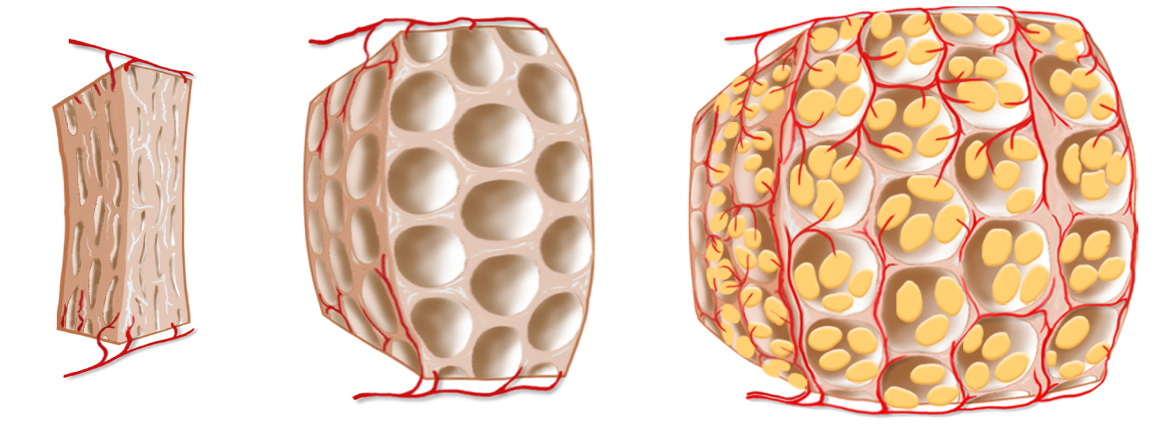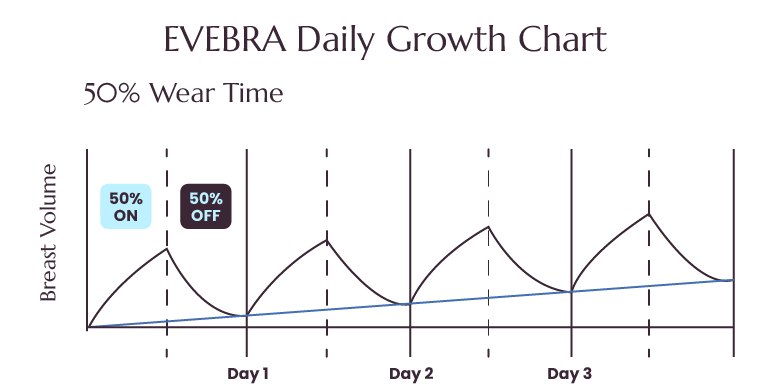Ground breaking bioengineering led to the development of EVEBRA
EVEBRA employs a gentle and sustained mechanical tension mechanism to lift and gradually enhance your breasts. This painless and natural approach harnesses the time-tested principle of tension-induced tissue growth. Similar to the way tension prompts bone lengthening during childhood, EVEBRA utilizes this principle to stimulate breast enlargement. This technique, rooted in medical practices like tissue expanders and the Ilizarov apparatus, ensures a safe and effective journey to a fuller bust line.
What is tension-induced tissue growth?
- When subjected to a gentle constant stretch, tissues tend to make room for the stretch by growing.
- We grow from infancy to adulthood because it is our bones that get longer and stretch the surrounding soft tissues inducing them to grow.
- This is a universal natural phenomenon scientifically observed in vascular, pulmonary, visceral, nervous, bony, muscular, and cutaneous tissues.
- This method is used as tissue expanders in the Ilizarov device for limb lengthening and facial bones distraction.
- No cancer risk has ever been associated with tension-induced tissue growth, it is actually thought to be cancer protective.
- Tension-induced tissue growth has years of scientific validation.
The Science Behind EVEBRA
The concept of tension-induced external vacuum expansion is rooted in the principle that controlled, sustained mechanical forces can stimulate tissue growth. This phenomenon is known as mechanotransduction, where cells within the tissue sense and respond to mechanical stress by altering their behavior and physiology, promoting growth and adaptation.
Key Scientific Principles Involved

Mechanical Distraction
The device applies a gentle vacuum (negative pressure) to the tissue, creating a stretching force. This force pulls the tissue outward, which initially causes elastic deformation (temporary stretch) of the tissue.
Mechanotransduction
Cells within the tissue respond to this mechanical stimulus by activating signaling pathways that lead to cellular growth and proliferation. Specific cellular components, such as integrins (cell surface receptors), play a crucial role in detecting mechanical forces and transmitting these signals inside the cell.
Fibroblast Activation
Fibroblasts, the cells responsible for producing collagen and other extracellular matrix components, are particularly responsive to mechanical stress. Under sustained stretch, fibroblasts increase their production of extracellular matrix, which adds volume and structural integrity to the tissue.
Angiogenesis
Sustained mechanical stretching also promotes angiogenesis, the formation of new blood vessels. This is crucial for supporting the newly forming tissues by supplying necessary nutrients and oxygen, thus facilitating sustained growth.
Tissue Homeostasis and Adaptation
With continuous application of tension, the tissue gradually adapts by expanding. This adaptation involves both the generation of new cells and the remodeling of existing cells and matrix structures to accommodate and stabilize the increased size.
Biological and Clinical Outcomes

Cellular Response
On the cellular level, the stretched cells undergo mitosis (cell division) more frequently, increasing the number of cells, and thus, the volume of the tissue.
Tissue-Level Changes
On the tissue level, the increase in extracellular matrix and vascularization supports the enlarged tissue, making the growth sustainable and stable.
Clinical Efficacy
Clinically, this method has shown to increase breast size significantly, with the growth being maintained even after the cessation of treatment, as demonstrated by the study findings.
What To Expect From Using EVEBRA
-

Before EVEBRA
Baseline State
Original small breast before treatment. The inset shows normal tissue density. The grape-like structure represents the glandular tissue, while the small yellow spots depict the fat lobules.
-

0-8 weeks of use
Early EVEBRA effect
Initiating the breast expansion process, EVEBRA creates a vacuum inside the domes that gently pulls the breast tissue outward. The figure above illustrates the loosening of normal tissue density as the tissues are gently stretched by the vacuum pull.
-

10-20 weeks of use
Late EVEBRA effect
Over time, the sustained vacuum pressure places the tissues under chronic tension. This sustained tension stimulates the tissues to enlarge and naturally respond by replacing it with our body's natural filler—fat.
-

Late result after stopping
Post EVEBRA
After discontinuing EVEBRA wear, the swelling edema gradually subsides, revealing the lasting real breast enlargement from the newly deposited fat. It is known in the scientific world that chronic edema is adipogenic (generates fat).
Daily Expectations of Using EVEBRA

Continuous daily wear of 12 or more hours can lead to noticeable breast enlargement, represented by the visible growth (red line). This enlargement includes temporary swelling, which recedes (blue line) when EVEBRA use is stopped, leaving behind true tissue growth.
The “Cinderella Effect”

While you might enjoy the temporary “Cinderella effect” of the visible swelling that result from short term use, only a fraction of that visible swelling is real tissue growth. Natural breast growth that happens during puberty takes months, even years, and EVEBRA is not going to outpace nature.
In order to achieve true breast growth, the edema must be maintained by uninterrupted daily wear of the EVEBRA over a few months. It is the accumulation of edema that is sustained over time which will result in true breast enlargement.
Scientists have proven that chronic edema is “adipogenic"; meaning the body tends to replace the fluid in the edema distended tissue with our natural filler which is fat. Our clinical data has shown that for true breast enhancement, the minimally effective wear pattern is to have the EVEBRA on for 50% of the time throughout the wear period.
50% Wear Time Graph:

The minimum amount of daily wear time that will leave you with some swelling by the time you resume EVEBRA wear the next day is 8-12 hours per day.
40% Wear Time Graph:

Having EVEBRA on for less time than having it off (less than 50% of the time) is one step forward one step backward without significant progress.
60% Wear Time Graph:

Wearing the EVEBRA for more than 50% of the time will accelerate
breast growth.
Missing a day of EVEBRA

Will cause significant loss of swelling that will require a couple of additional days of more than 50% wear to catch up and compensate.







